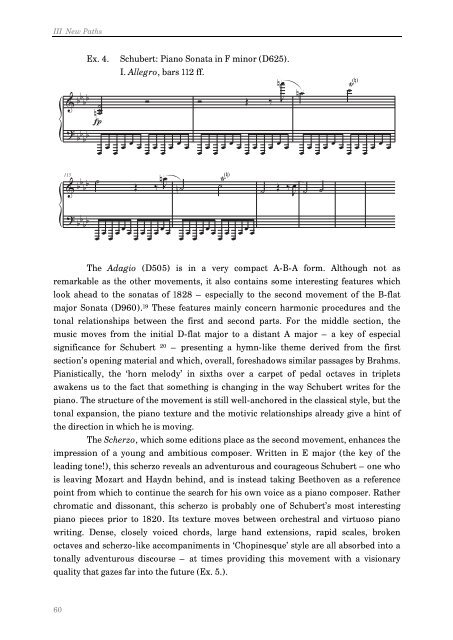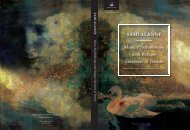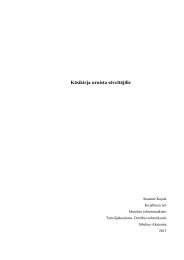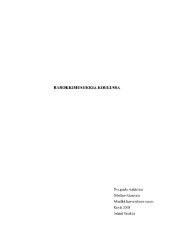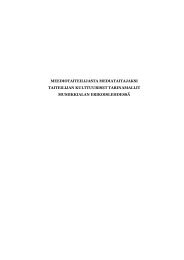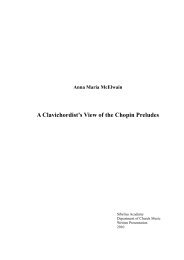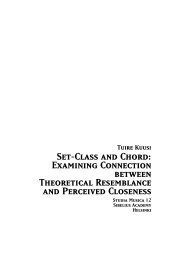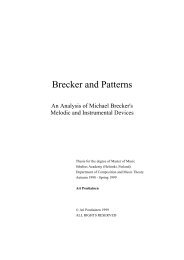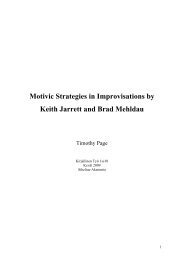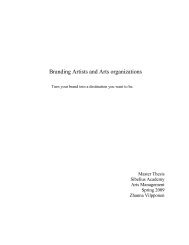The Unfinished Piano Sonatas of Franz Schubert Javier ... - Ethesis
The Unfinished Piano Sonatas of Franz Schubert Javier ... - Ethesis
The Unfinished Piano Sonatas of Franz Schubert Javier ... - Ethesis
Create successful ePaper yourself
Turn your PDF publications into a flip-book with our unique Google optimized e-Paper software.
III New Paths<br />
& b<br />
?<br />
b b b<br />
b b b b<br />
n ˙<br />
Í<br />
115<br />
& b b b b<br />
?<br />
b b b b<br />
Ex. 4. <strong>Schubert</strong>: <strong>Piano</strong> Sonata in F minor (D625).<br />
˙<br />
I. Allegro, bars 112 ff.<br />
œ œ œ œ œ œ œ œ œ œ œ œ<br />
Ó<br />
Œ ‰ J œ n (<br />
œ œ œ œ œ œ œ œ œ œ œ œ<br />
Ó Œ ‰<br />
n œ<br />
J<br />
(<br />
œ œ œ œ œ œ œ œ œ œ œ œ<br />
n ˙<br />
) ˙ ŸÈ ( )<br />
œ œ œ œ œ œ œ œ œ œ œ œ<br />
˙ Œ ‰ J œ ˙ ˙<br />
( )<br />
n ˙)<br />
˙ŸÈ<br />
œ œ œ œ œ œ œ œ œ œ œ œ<br />
<strong>The</strong> Adagio (D505) is in a very compact A-B-A form. Although not as<br />
remarkable as the other movements, it also contains some interesting features which<br />
look ahead to the sonatas <strong>of</strong> 1828 – especially to the second movement <strong>of</strong> the B-flat<br />
major Sonata (D960). 19 <strong>The</strong>se features mainly concern harmonic procedures and the<br />
tonal relationships between the first and second parts. For the middle section, the<br />
music moves from the initial D-flat major to a distant A major – a key <strong>of</strong> especial<br />
significance for <strong>Schubert</strong> 20 – presenting a hymn-like theme derived from the first<br />
section’s opening material and which, overall, foreshadows similar passages by Brahms.<br />
Pianistically, the ‘horn melody’ in sixths over a carpet <strong>of</strong> pedal octaves in triplets<br />
awakens us to the fact that something is changing in the way <strong>Schubert</strong> writes for the<br />
piano. <strong>The</strong> structure <strong>of</strong> the movement is still well-anchored in the classical style, but the<br />
tonal expansion, the piano texture and the motivic relationships already give a hint <strong>of</strong><br />
the direction in which he is moving.<br />
<strong>The</strong> Scherzo, which some editions place as the second movement, enhances the<br />
impression <strong>of</strong> a young and ambitious composer. Written in E major (the key <strong>of</strong> the<br />
leading tone!), this scherzo reveals an adventurous and courageous <strong>Schubert</strong> – one who<br />
is leaving Mozart and Haydn behind, and is instead taking Beethoven as a reference<br />
point from which to continue the search for his own voice as a piano composer. Rather<br />
chromatic and dissonant, this scherzo is probably one <strong>of</strong> <strong>Schubert</strong>’s most interesting<br />
piano pieces prior to 1820. Its texture moves between orchestral and virtuoso piano<br />
writing. Dense, closely voiced chords, large hand extensions, rapid scales, broken<br />
octaves and scherzo-like accompaniments in ‘Chopinesque’ style are all absorbed into a<br />
tonally adventurous discourse – at times providing this movement with a visionary<br />
quality that gazes far into the future (Ex. 5.).<br />
60


